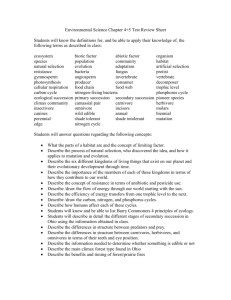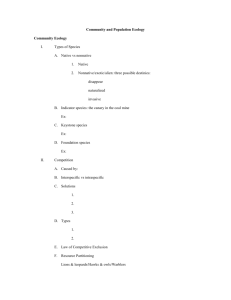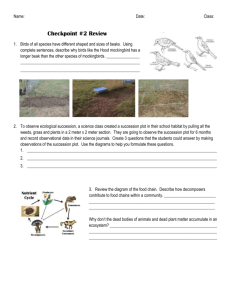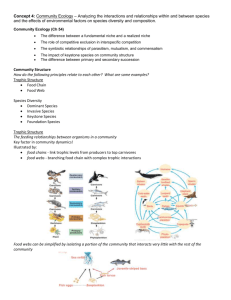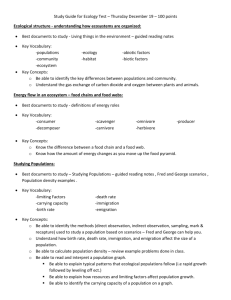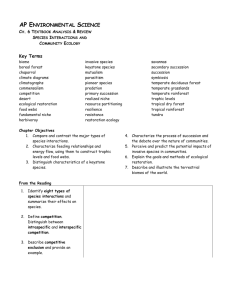Exam 2 Answer Key
advertisement
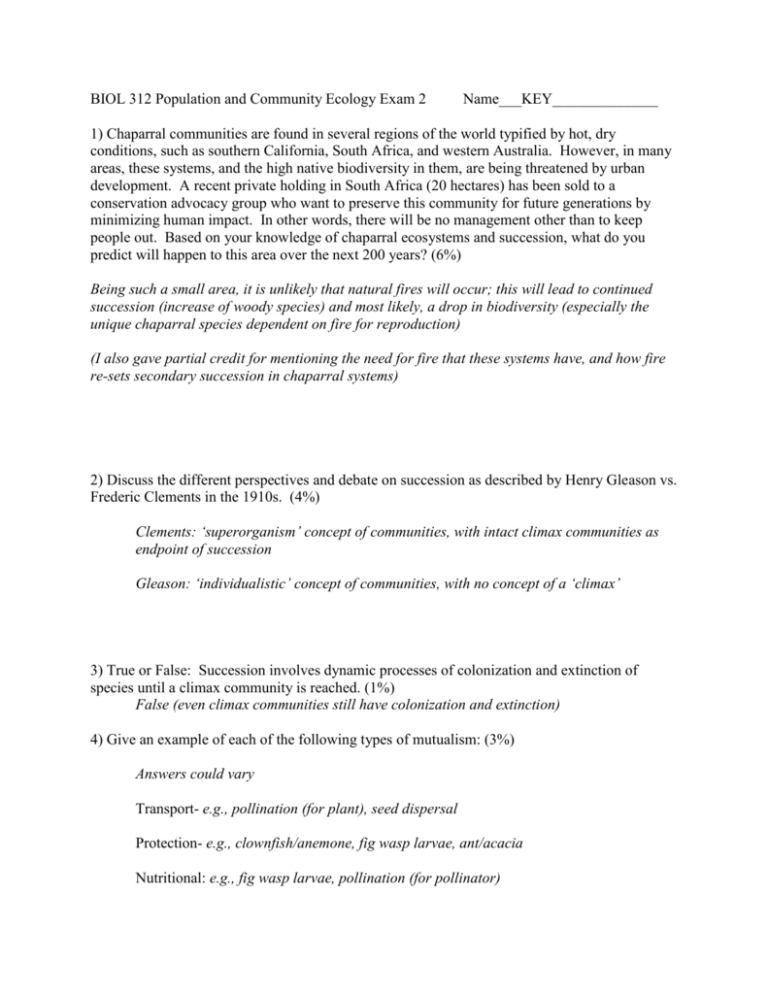
BIOL 312 Population and Community Ecology Exam 2 Name___KEY______________ 1) Chaparral communities are found in several regions of the world typified by hot, dry conditions, such as southern California, South Africa, and western Australia. However, in many areas, these systems, and the high native biodiversity in them, are being threatened by urban development. A recent private holding in South Africa (20 hectares) has been sold to a conservation advocacy group who want to preserve this community for future generations by minimizing human impact. In other words, there will be no management other than to keep people out. Based on your knowledge of chaparral ecosystems and succession, what do you predict will happen to this area over the next 200 years? (6%) Being such a small area, it is unlikely that natural fires will occur; this will lead to continued succession (increase of woody species) and most likely, a drop in biodiversity (especially the unique chaparral species dependent on fire for reproduction) (I also gave partial credit for mentioning the need for fire that these systems have, and how fire re-sets secondary succession in chaparral systems) 2) Discuss the different perspectives and debate on succession as described by Henry Gleason vs. Frederic Clements in the 1910s. (4%) Clements: ‘superorganism’ concept of communities, with intact climax communities as endpoint of succession Gleason: ‘individualistic’ concept of communities, with no concept of a ‘climax’ 3) True or False: Succession involves dynamic processes of colonization and extinction of species until a climax community is reached. (1%) False (even climax communities still have colonization and extinction) 4) Give an example of each of the following types of mutualism: (3%) Answers could vary Transport- e.g., pollination (for plant), seed dispersal Protection- e.g., clownfish/anemone, fig wasp larvae, ant/acacia Nutritional: e.g., fig wasp larvae, pollination (for pollinator) 4b) For one of your examples above, list the costs and benefits for each species in the mutualism. (4%) Answers varied 4c) Explain how environmental factors, such as nutrient availability, might affect the strength of one of your mutualisms listed above. (3%) Answers varied, but I gave full credit if you said that when costs are greater than benefits because of environmental factors, a mutualism switches to become a parasitism 5) What is a trophic cascade? (2%) An indirect effect where a predator reduces the abundance of prey and this cascades to increase abundance in next lowest trophic level (and so on) 6) Why are trophic cascades more easily found in aquatic systems than in terrestrial systems? (4%) (any two of the following four reasons got you full credit) -population dynamics at each trophic level are relatively fast -trophic levels are discrete -species interactions are strong -(little is known about terrestrial systems, especially belowground…e.g., the Wardle paper) 7) Recently, Gull Lake residents became concerned because of growth of large algal blooms in the lake, which caused reduced water clarity and unpleasant swimming conditions. Based on what you know of lake aquatic food webs, describe both a bottom-up and a top-down explanation for these algal blooms. (4%) Bottom-up: increased nutrient inputs (e.g. fertilizer runoff) caused increase in algae Top-down: increased planktivorous fish due to stocking (or decreased piscivorous fish due to overfishing) decreased zooplankton, which allowed algae to bloom 8) Tilman tested his resource ratio in two systems. Briefly explain each, indicate which one supported his theory, and give reasons for why the theory worked in one system and not the other. (5%) He tested his ideas with algae in a chemostat and plants in a Minnesota old-field. The resource ratio model worked for the protests probably because it was a well-mixed system (low heterogeneity) and organisms had fast generation times that were likely to reach an equilibrium. 9) Briefly give five explanations for why many communities have higher species richness than predicted by simple competition models (e.g. Lotka-Voltera). Full sentences are unnecessary. (5%) No age or genetic structure No migration/dispersal No time lags Resources are limited supply Alphas Density dependence is linear Spatial heterogeneity Temporal heterogeneity Disturbance Predation Aggregation I decide that this question was a little vague to I also accepted some other answers that are not technically correct but illustrate that you were aware of some of the issues. 10) Draw a graph illustrating MacAurthur and Wilson’s model of island biogeography. Label the axes and draw a function for near, far, small, and large islands. Briefly explain how this model might be applied to the design of nature reserves. (10%) Small Near RATE Large Far NUMBER OF SPECIES S Any logical connection between the model and reserve design was given full credit 11) Explain what the target effect and rescue effect are and how they relate to MacAurthur and Wilson’s model. (4%) Target effect: immigration is higher on large than small islands because they are easier to find (e.g. birds) or be ‘hit’ by wind dispersed species Rescue effect: extinction rates are lower on large than small islands because they receive more immigration potentially rescuing species that are nearing extinction 12) Assuming that two populations start at point A, what is the predicted competitive outcome? (5%) N2 K 1 / 12 80 60 K2 40 20 A 20 40 K1 60 80 N1 K 2 / 21 Two species will coexist. Intraspecific competition is higher than interspecific competition. 13) Based on the following figure, which species would you predict will win in competition? (5%) Birth rate of species B Mortality rate of species B Rate Birth rate of species A Mortality rate of species A Resource Availability Species A will out-compete species B because species A can maintain positive population growth rates at lower resource levels than species B. 14) Give two reasons why diversity may be important to ecosystem functioning (1 sentence). In class, we discussed two tests of this idea. Explain one and give the general result from the experiment (3 sentences or less). (5%) Complementarity, insurance effect. Tilman manipulated plant species in a Minnesota old-field and looked at N cycling. He found higher productivity and less N loss with higher diversity. Naeem manipulated diversity in three trophic levels in a growth chamber and found high production in complex compared to simplified food web. (This turned out to be a difficult question so we accepted answers that had at least one reason for the importance of diversity to ecosystem function and correctly identified the diversity-ecosystem function experiment). 15) We discussed how species diversity relates to eight different environmental gradients. List four of these environmental gradients and how one group or organisms (e.g. birds, mammals, etc) relates to each gradient. (4%) Latitude (S decreases with latitude: lizards, trees, butterflies, bivalves) Succession (S increases with succession: birds, insects) pH (S increases with pH: plants, inverts) Disturbance (S is unimodal: algae, insects, phytoplankton) Ocean/lake depth (S is negative to unimodal: megabenthos) Temperature (S decreases with temp range: birds, mammals, gastropods) Productivity (S increases with productivity: birds, mammals, amphibians, reptiles) Elevation (S decreases with elevation: birds, mammals, plants 16) A friend is planning a trip across the U.S. and is looking for destinations that might have a high diversity of mammals in their natural habitats. Where would you tell them to go and why? (4%) Southern, rocky mountains or mountains in California. Mountains have high heterogeneity (many habitats compressed into small spatial area). Diversity often increases at lower latitudes. 17) Give a definition for a community. Include four ways that people have tried to define communities. (5%) Simplest definition: is a group of interacting organisms defined by physical, statistical, taxonomical or by species interactions. 18) Copper sulfate is used to control weeds in lakes and ponds. A colleague wants to compare zooplankton communities in lakes with or without copper sulfate but is not sure what to measure. What are some of the options and what are the strengths and weakness of each? (5%) One could measure species richness, evenness and composition. Some had trouble recognizing that the question focuses on what to measure and how to compare communities. I accepted a variety of answers that at least included richness and abundance. 19) What is the effect of the predator (Typhlodromus) on the prey (Eotetranychus)? (4%) Introduction of predator leads to decreased amplitude and increased period. The predator did NOT cause oscillations as the prey cycles in the absence of the predator 20) Organisms respond to predation in many ways. Provide four examples. (4%) Masting, increased growth/flowering, chemical defense, physical defense, mimcry, intimidation, group behavior, spatial separation, etc. 21) Louda examined the importance of herbivory from the coast to inland sites in California. She used an insecticide to remove/reduce herbivores. What conclusions can you draw from this study? (4%) There were a wide variety of answers. I did not deduct points for this question.
